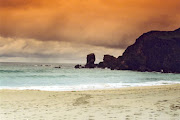I would be about 6/7 years old (1947/1948),and my two month summer idyll was just beginning in Dalmore. There was going to be the grandest of weddings ever held in this village, at any time in the past. Problem was that my sweetheart,Mairi Long (Mary Macleod from Borriston)had decided to marry Seoras Dhomhnull Chalum (George Macleod from No. 8 Dalmore). I had mentioned to "my Mary" that consanguinity could be a problem,but she assured me that they came from different "branches" of the clan . There's a lot of Macleods in Lewis. My mother was a Macleod who married a Maclennan,and they were second cousins! I should have read the signs during previous summers as I watched the most beautiful stone house rising beside the old black house at No.8,under Seorais' supervision.The stone came from the hill above the house,transported downhill by horse and dry sled to be fashioned by the stonemasons.I can still picture perhaps half a dozen fires burning on the hillside and can still smell the sweet smell of peat smoke.They built those fires around the larger stones,where the heat and the deft use of a crowbar would split the stone along the desired line. Even back then,I realised that George had more to offer Mary, and so I gave them my blessing!
Mary and George were a popular couple in the district, and their wedding would be on the grand scale. The wedding in these days was a three day affair. Firstly there was the "village wedding"(Gael. banais a' bhaile),the following day,the wedding proper(in church,never a civil ceremony),and finally on day 3,the wedding honouring the relatives of both sides(Gael. banais na cairdean). Of course,the evening of the church wedding was a massive affair which could cater for hundreds of guests.A person would be sent out to issue an invitation to a whole village,simply by word of mouth. That person issued the invitation to those in the first house he came to,and the good news spread from there. It was possible that perhaps four or five villages would descend on Dalmore for the marriage of Mary and George. This was a form of "firey cross",with love taking the place of war. Another attractive custom was, that every house on the route between the wedding house and the church,flew a white flag(sheet,pillowcase) by the road. This was an emblem of purity,and not ,as some cynics suggested,one of surrender.
People attending the wedding would hand in a chicken,some would bring a wedder(near relatives or close friends). These gifts of food were essential if the multitudes were to be fed,and were usually handed over,a day or two in advance of the nuptial feasts. The chickens were dispatched by women sittng in the open - feathers plucked,gutted and washed ready for the large steaming cauldrons,placed here and there on the hillside. Men dealt with the sheep. A great many sittings were required to feed the large number of people,and the barn in the old house is where the bride and groom entertained their many guests. The barn was transformed into a long white "cocoon" with the stone walls and roof completely covered with white sheets. Lit by oil lamps and storm lanterns,it was a truly beautiful venue. Each sitting could accommodate perhaps 30 guests and Mary and George would be present at the top of the table. It was also the custom then for people to place money in front of the bride,perhaps a one pound note,which was a decent sum in 1947/48.
The guests would be served a tasty chicken broth,chicken and mutton with potatoes and some vegetables,and "pudding". Scones,pancakes and cake were then served with tea. A whisky and a glass of beer were given to all at the table to toast the newlyweds.There would be many more sittings and a great many more "drams" before the night would end. There would be music and dancing in another part of the old "taigh dubh",eased along with some barrels of ale, and whisky, that had escaped the wives' notice. Even some ministers were known to have a "wee sensation" on a night like this.
That was certainly a wedding to remember, and what passes now for a wedding, is but a pale imitation of one of the great Highland celebrations of the past.
Dalmore Daytime

Sandy Beach
Tuesday, 1 April 2008
Subscribe to:
Post Comments (Atom)


No comments:
Post a Comment